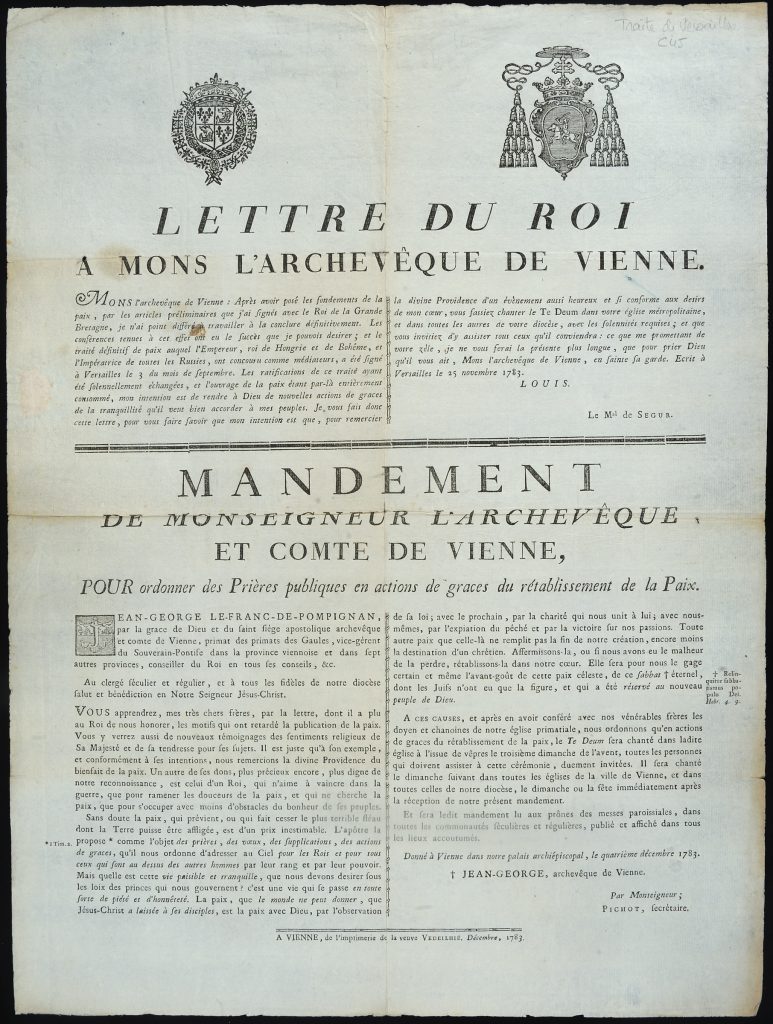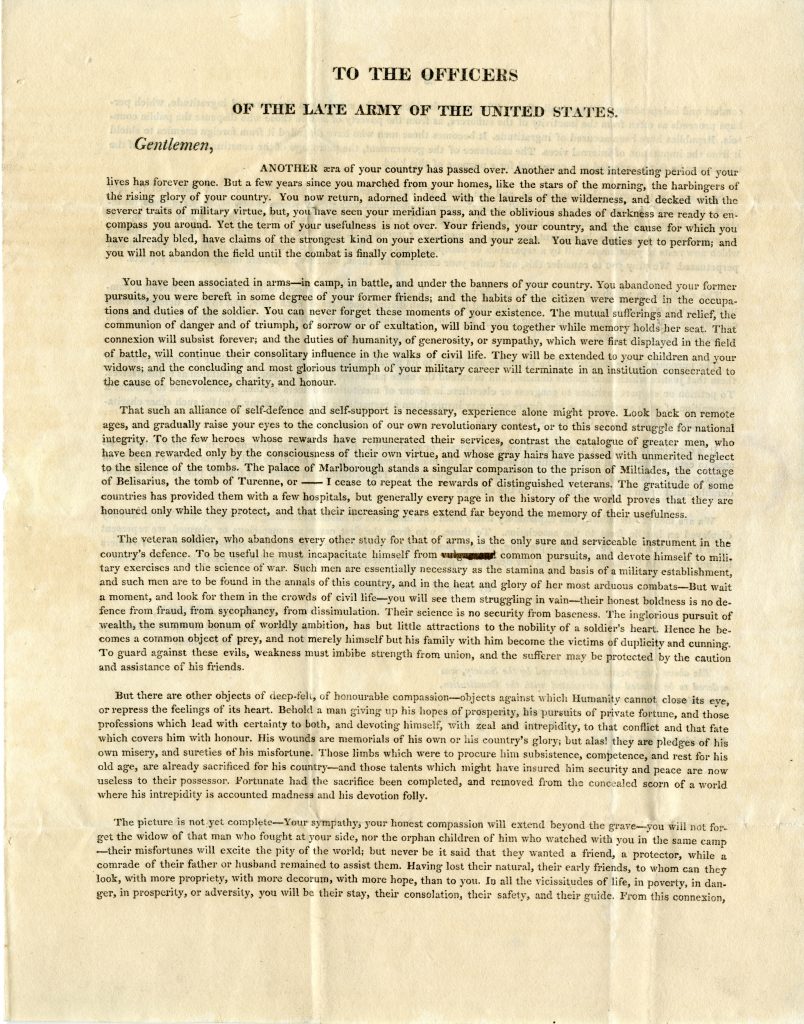The single-sheet printed items of the broadside collection were created to disseminate news, announce legislation, recruit and instruct troops, celebrate great events or sway public opinion. Often quickly and cheaply produced, broadsides were typically considered ephemeral items to be discarded after their original use. The collection includes several rare survivals, such as official acts and proclamations issued by the individual states and the Continental Congress during the Revolutionary War, as well as general orders of the Continental forces. French and British examples include royal ordinances and proclamations relating to military and naval preparations, charts of the military establishments, diagrams of the manual exercise, and naval sailing and fighting signals.
The enduring influence of the Revolution is documented in broadsides celebrating the anniversaries of wartime events, some published well into the nineteenth century. Revolutionary War veterans published poignant accounts of their post-war hardships in support of their petitions to Congress for relief.
Other examples document the effect of the War of 1812 on the memory of the Revolution as well as political divisions among Revolutionary War veterans in the early nineteenth century. Poetry and songs were often circulated in broadside form, and the Institute’s collections include several entertaining examples with military and naval themes.
![Click for a larger view. Sailing and Fighting Signals, Observ’d by His Majesty’s Ships of War and Merchants Ships that Sail with Convoy, William Coard, London: Sold by Willm. Mount and Thos. Page, [ca. 1750]](https://www.americanrevolutioninstitute.org/wp-content/uploads/2018/08/Sailing-and-fighting-signals-by-Coard-BROAD-L2006F47-767x1024.jpg)
Sailing and Fighting Signals, Observ’d by His Majesty’s Ships of War and Merchants Ships that Sail with Convoy
William Coard
London: Sold by Willm. Mount and Thos. Page, [ca. 1750]The Robert Charles Lawrence Fergusson Collection
Abstracted from the official handbook of the Royal Navy, this hand-colored chart details signals to be used by day, by night, in a fog and in combat.![Click for a larger view. Carte Militaire des Troupes de France, sur Pied, pour l’Année 1775, Ministère de la Guerre de France, [Paris], 1775](https://www.americanrevolutioninstitute.org/wp-content/uploads/2018/08/Carte-militaire-des-troupes-de-France-BROAD-L2006F233f.jpg)
Carte Militaire des Troupes de France, sur Pied, pour l’Année 1775
Ministère de la Guerre de France
[Paris], 1775The Robert Charles Lawrence Fergusson Collection
This statistical digest of the military strength of France the year the Revolutionary War began includes a color-coded chart of uniform colors by branch of service.![Click for a larger view. The Invitation of the Continental Congress, to Their Brethren Who Are Sons of Liberty and Seamen, to Engage in the Defence of the Liberties of America, Continental Congress, [Philadelphia, 1775]](https://www.americanrevolutioninstitute.org/wp-content/uploads/2018/08/Invitation-of-the-Continental-Congress-BROAD-L2014F196ff-652x1024.jpg)
The Invitation of the Continental Congress, to Their Brethren Who Are Sons of Liberty and Seamen, to Engage in the Defence of the Liberties of America
Continental Congress
[Philadelphia, 1775]The Robert Charles Lawrence Fergusson Collection
This printed broadside, laying out the terms and benefits of enlistment in the Continental Navy, includes the signatures of those signing on for service on the Continental Navy ship Columbus under the command of Abraham Whipple of Rhode Island. The roster includes twenty-one officers and midshipmen, ninety-two seamen, landsmen, craftsmen and gunners, and one “negro boy,” with their dates of enlistment, rank and rate of pay.![Click for a larger view. General Orders for the Army under the Command of Brigadier General M’Dougall…. Instructions for Soldiers in the Service of the United States, Concerning the Means of Preserving Health. Of Cleanliness, George Washington, [Fishkill, N.Y.: Samuel Loudon, 1777]](https://www.americanrevolutioninstitute.org/wp-content/uploads/2018/08/General-orders-for-the-Army-under-Dougall-by-Washington-BROAD-L92.1.471-645x1024.jpg)
General Orders for the Army under the Command of Brigadier General M’Dougall…. Instructions for Soldiers in the Service of the United States, Concerning the Means of Preserving Health. Of Cleanliness
George Washington
[Fishkill, N.Y.: Samuel Loudon, 1777]The Robert Charles Lawrence Fergusson Collection
“It is extremely difficult to persuade Soldiers that Cleanliness is absolutely necessary to the Health of an Army,” Washington advised his colonels in command of the regiments. In his general orders on health and hygiene in military camps, he cited Moses as the “wisest general who ever lived,” invoking the “Rules of Cleanliness” laid out in the Bible as the model for the Continental Army.![Click for a larger view. The Following Return of the Prisoners, Taken at Forts Montgomery and Clinton, Are Published for the Satisfaction of the Public, and Particularly for the Benefit of Their Relations, Joshua Loring, [New York, 1778]](https://www.americanrevolutioninstitute.org/wp-content/uploads/2018/08/Return-of-the-prisoners-by-Loring-BROAD-L2012F152m-685x1024.jpg)
The Following Return of the Prisoners, Taken at Forts Montgomery and Clinton, Are Published for the Satisfaction of the Public, and Particularly for the Benefit of Their Relations
Joshua Loring
[New York, 1778]The Robert Charles Lawrence Fergusson Collection
Joshua Loring was deputy commissary of prisoners for the British army. He circulated this broadside listing 263 Americans captured at the battles of Fort Montgomery and Fort Clinton in October 1777, to solicit donations of provisions from the prisoners’ families.![Click for a larger view. Oath of allegiance to the United States [Philadelphia: John Dunlap, 1778]](https://www.americanrevolutioninstitute.org/wp-content/uploads/2018/08/BROAD-L2019S3-M-Loyalty-Oath-large-850x1024.jpg)
Oath of allegiance to the United States
[Philadelphia: John Dunlap, 1778] Purchased with the gift of a private foundation, 2019
![Click for a larger view. A Receipt for a Cheap Soup for Six Persons; Published for the Use of the Private Soldiers and Their Families, Encamped on Cox-Heath, near Maidstone, 1778, Thomas Shipley, [Maidstone, England, 1778]](https://www.americanrevolutioninstitute.org/wp-content/uploads/2018/08/Receipt-for-Cheap-Soup-by-Shipley-BROAD-L2010F191m-828x1024.jpg)
A Receipt for a Cheap Soup for Six Persons; Published for the Use of the Private Soldiers and Their Families, Encamped on Cox-Heath, near Maidstone, 1778
Thomas Shipley
[Maidstone, England, 1778]The Robert Charles Lawrence Fergusson Collection
A British inventor created and published at his own expense this versatile recipe for a healthful soup, which he circulated to the soldiers stationed at Coxheath, a military training camp set up for the defense of the British homeland. The soup, he promised, could be made for just a penny a serving and will “be a very wholesome and pleasant food, and will serve very well at the Tables of the Rich, as well as the Poor.”![Click for a larger view. Lt. Col. Holroyd’s Light Dragoons. Song, in Honour of the 22d Light Dragoons. To the Tune of Hearts of Oak. [ca. 1780]](https://www.americanrevolutioninstitute.org/wp-content/uploads/2018/08/Lt.-Col.-Holroyds-light-dragoons-BROAD-L2015F121-683x1024.jpg)
Lt. Col. Holroyd’s Light Dragoons. Song, in Honour of the 22d Light Dragoons. To the Tune of Hearts of Oak.
[ca. 1780]The Robert Charles Lawrence Fergusson Collection
Issued at a time when Britain was preparing its defenses against a French invasion, this song sheet was designed to seek recruits for the Sussex (or Twenty-second) Light Dragoons under the command of Lt. Col. John Baker Holroyd.
Lettre du Roi a Mons l’Archevêque de Vienne…. Mandement de Monseigneur l’Archevêque et Comte de Vienne, pour Ordonner des Prières Publics en Actions de Graces du Rétablissement de la Paix
Louis XVI
Vienne: De l’imprimerie de la veuve Vedeilhié, 1783The Robert Charles Lawrence Fergusson Collection
This open letter of the king of France to the archbishop of Vienna announced the treaty of peace ending the war with Great Britain and called for the Te Deum to be sung. The archbishop’s reply ordering prayers in celebration of the occasion is also printed.![Click for a larger view. Loi qui Confère le Titre de Citoyen Français à Plusieurs Étrangers: du 26 Août 1792, l’An Quatrième de la Liberté, Assemblée Nationale Législative, Angoulême: Chez Pierre Bargeas, Libraire, imprimeur du département, [1792]](https://www.americanrevolutioninstitute.org/wp-content/uploads/2018/08/Loi-qui-confere-le-titre-de-citoyen-BROAD-L2013F180-802x1024.jpg)
Loi qui Confère le Titre de Citoyen Français à Plusieurs Étrangers: du 26 Août 1792, l’An Quatrième de la Liberté
Assemblée Nationale Législative
Angoulême: Chez Pierre Bargeas, Libraire, imprimeur du département, [1792]The Robert Charles Lawrence Fergusson Collection
The French National Assembly conferred honorary citizenship to foreigners whose “writings and courage” served the cause of liberty. Among those honored in 1792 were Joseph Priestley, Thomas Paine, Jeremy Bentham, William Wilberforce, George Washington, Alexander Hamilton and Thaddeus Kosciuszko.![Click for a larger view. Evacuation of N. York. In Commemoration of this Happy Event, on Wednesday Evening, the 25th of November 1807, William Dunlap, [New York: Park Theatre, 1807]](https://www.americanrevolutioninstitute.org/wp-content/uploads/2018/08/Evacuation-of-New-York-by-Dunlap-BROAD-L2010F11-414x1024.jpg)
Evacuation of N. York. In Commemoration of this Happy Event, on Wednesday Evening, the 25th of November 1807
William Dunlap
[New York: Park Theatre, 1807]The Robert Charles Lawrence Fergusson Collection
This broadside announced the presentation of a “Grand Transparent Painting” representing the genius of America to be illuminated against the front of the Park Theatre in New York on the occasion of the twenty-fifth anniversary of the British evacuation of New York City, November 25, 1807.
To the Officers of the Late Army of the United States
Belisarian Association
Philadelphia, June 15, 1815The Robert Charles Lawrence Fergusson Collection
Lt. Col. Eli B. Clemson of the Sixteenth Infantry, United States Army, circulated this appeal to form a benevolent organization for veterans of the War of 1812, to be named for the Roman general Flavius Belisarius and modeled after the Society of the Cincinnati. This copy was sent to Col. Jacob Kingsbury, a veteran of both wars and an original member of the Society of the Cincinnati in the State of Connecticut. The Belisarian Association was never formally organized.![Click for a larger view. Who Is the Hero of Saratoga….General Dearborn or Brooks? Let the Official Report of the Commander in Chief of the Republican Army Answer!! [Boston: Printed by Adams & Rhoades, 1817]](https://www.americanrevolutioninstitute.org/wp-content/uploads/2018/08/Who-Is-the-Hero-of-Saratoga-BROAD-L2013F247-691x1024.jpg)
Who Is the Hero of Saratoga….General Dearborn or Brooks? Let the Official Report of the Commander in Chief of the Republican Army Answer!!
[Boston: Printed by Adams & Rhoades, 1817]The Robert Charles Lawrence Fergusson Collection
This inflammatory broadside attacking the war record of Governor John Brooks, a Federalist, was issued by Democrat Henry Dearborn, his opponent in Brooks’s run for reelection for the governorship of Massachusetts. Dearborn and Brooks were veterans of the Revolutionary War and fellow members of the Society of the Cincinnati.![Click for a larger view. The Old Soldier—A Fact. Americans! Read and Reflect, Printed by order of a few surviving soldiers of the Revolution, [1828]](https://www.americanrevolutioninstitute.org/wp-content/uploads/2018/08/BROAD-L2009F89-The-Old-Soldier-A-Fact-conserved-large-661x1024.jpg)
The Old Soldier—A Fact. Americans! Read and Reflect
Printed by order of a few surviving soldiers of the Revolution, [1828]The Robert Charles Lawrence Fergusson Collection
This broadside recounts the story of Richard Nagle, a Revolutionary War veteran from Pennsylvania, who walked to Washington, D.C., to seek his pension. He was rebuffed by Congress, and met with President John Quincy Adams at the White House, who is supposed to have said, “Begone you impostor, and dirty old rascal, or I’ll have you horse-whipped.” The story was also reported in several newspapers at the time, and Nagle eventually received a “gratuity” of $40 for his Revolutionary service from the state of Pennsylvania.